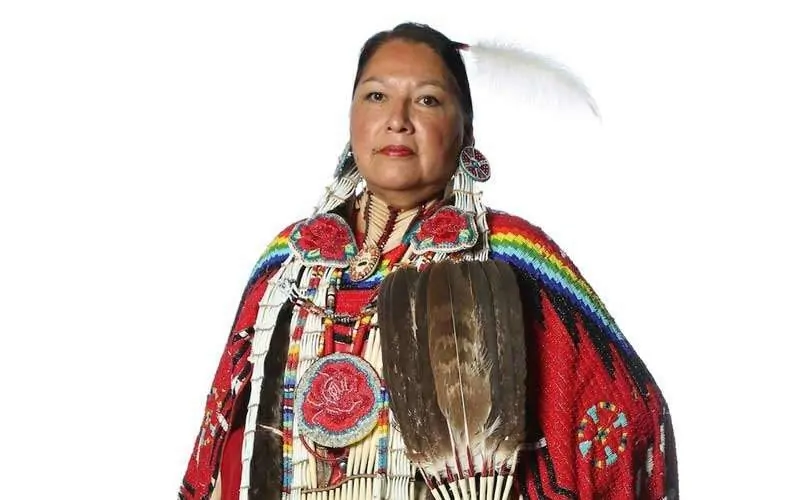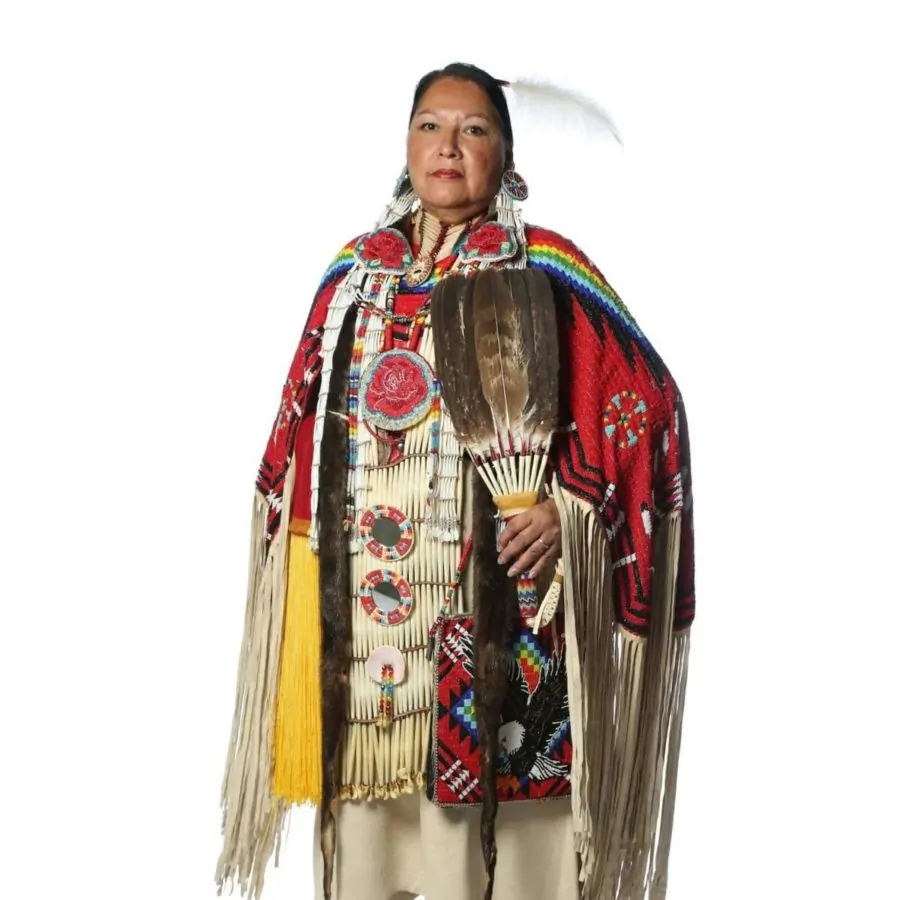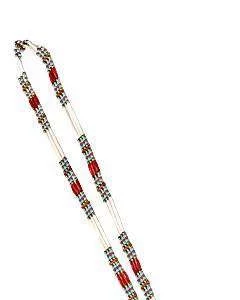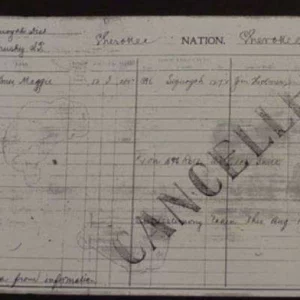The pow-wow trail is full of superstars, Olympians, and true Champions, women’s traditional dancer Linda Standing is one of them, she comes from White Bear First Nation in Saskatchewan, she’s Dakota, Nakota, Anishinabek and Cree descent.
Linda started dancing at the young age of 12 years old. “White Bear Saskatchewan always had an annual pow-wow and my grandpa was the chief at the time, he was always hosting the pow wow. We were always involved and as I got older my grandma would make me wrap around moccasins with a little bit of beadwork on it, then she’d put on a buckskin dress on me. I was tall enough to fit into it, there was some beadwork on the shoulders. She put on her beaded belt her headband on my hair and she sent me out dancing, she’d tell me how to hold my shawl and how to dance.”
When Standing first started dancing she felt nervous and had to keep on time with the beat of the drum. “The things my grandmother told me to do, like how to move my feet and be natural. I just kept doing that and I really started getting into it when I was about 15 years old. My biggest way of learning was observation and practice.” Standing would observe what the other dancers were doing in her age category and she would try it. Along with dancing, she would try different types of sewing and beadwork. “My grandmother also taught me how to bead and she taught me how to sew.”
The pow-wow trail allowed Standing to travel extensively throughout Canada and the United States at a young age. “My dad is Dakota from Wahpeton Nation. He and my mom would come and get me in the summer and they would take me to Pow-wows. They would take me to Standing Buffalo, SK Sioux Valley MB Pipestone MB as well as Fort Totten ND, Bismarck ND Poplar MT Crow Agency MT that was the prairie circuit at that time.” As she started getting into dancing she started getting into the pow wow circuit when she was 15-17 years old. Her interest grew more and she began traveling around with her cousin Sara MacArthur from White Bear SK. “She always had a vehicle and I had a driver’s license when I was 16, so she’d always pick me up and we’d go. She would dance as well and I was her driver. And I became interested in more and more and meeting more friends and dancing.”
Eventually Standing sewed her own outfit she was out there dancing in the pow-wow arena with everyone. She started off with dancing fancy shawl and transitioned into traditional dance. “I started off with woman’s fancy where you lift your feet off the ground and have your shawl and back in the day you danced near the drum, and zig zag you didn’t too many circles. The dancers developed their own style of dancing,” adding, “There were some women who had their own style that you idolized, like Yvonne Merrick from New Town, ND area.”
Standing recalls whatever you could find or put on or whatever you could make and it didn’t matter. It was getting out there and feeling the beat of the drum and feeling it in your heart and going with it naturally. “Grandma said dance natural, don’t dance stiff. Those were the teachings I got from my grandparents and you must be very respectful in the arena and be very respectful to the drum.”
Standing recalls, “Back then, there were competitions but when I think of it now the main reason wasn’t really the competition of the pow wows it was mainly the gathering, the social gathering of the pow wow and that is why you went. You went to visit, you went to pitch up your tent, you went with all your bedding, and your camping supplies.” Adding, “I remember pitching up the white tent with my grandma. And she’d start cooking, I can remember hearing the pow wow drums in the background and my grandpa would always go up there first. He would have on his buckskin outfit and headdress he must have been going to represent our community as a leader.” Standing said, we always had lots of friends where ever we went. Just like now, its like a big family.
“As I get older I try to live healthier and try to be healthy I don’t want to be sickly grandma that has diabetes or cancer or ailment. I want to enjoy my elderly years with my grandchildren. My grandfather lived to be 92 and they did have some conditions My grandpas has arthritis my grandmother had diabetes,” said Standing. She has five grandchildren and adopted children.
Teachings from her grandfather (Anishinabek & Cree) from the Saulteaux teachings and spoke Cree. My grandmother has Lakota and Nakota teachings. Her grandma would tell her ‘You’re preparing to look your best for your ancestors that are there with you within that circle when you dance. You dress yourself in your best regalia because you are honoring your ancestry when you dance.’
Certain tribes have certain ways on how they dress, they have certain beadworks styles and all these things you are taught as you are growing up. I learned a lot from my grandparents and dad Dakota’s side. I have a jingle dress, my traditional beaded outfit, an Ojibway style beaded outfit. I’ve made all these different types of outfits that represented all my nationalities in my background. We are also taught to know who your relatives are. Because no matter where you travel too, you might find a relative somewhere you think that you won't know anybody.
When I’m getting ready to dance when I braid my hair when I start to put on my regalia, and then I start thinking about how I feel when I’m dancing, I feel good, I feel excited. It gives you energy. You get that feeling of excitement that you want to dance. Those are the teachings we must keep alive in the circle. Speakers at a pow wow speak about old values and talk about how we must continue those values and how we must pass on to our youth and young people.
When a really good song is sung, Standing explained, “It makes me feel like something comes over you, like a spirit. Sometimes like energy maybe it's something that comes and it carries you through the song. That song that you are dancing to, the melodies, the drum beat and the words of the song… it just kind of carries you like its almost effortless to dance, and if you have aches and pains you don’t feel them. You don’t even think of it, that’s how good that song makes you feel. Sometimes I’ve heard other dancers say, ‘Gee… I haven t danced like that in such a long time.’ And ‘Oh, that song had a good spirit with it.’ And when we go and line up us ladies would be huffing and puffing and we d be saying oh wow that was such a good song it makes you just feel awesome.”
Standing’s most memorable competition pow wow would be back in 1985 when I used to go to United Tribes pow wow in Bismarck North Dakota. That was the big end of the year pow wow in September before everyone went back to work or school for the fall. She remembers sitting back at the camper and had just torn down the camp. They were starting to call the winners. She was starting to pack their stuff away, and kind of rushing to get everything packed cause they had to travel back to Canada. They started calling the winners. Standing said, “I think they were announcing 4th or 5th place, and they were calling the names of good dancers. I thought Oh I guess I didn’t make it because I thought if I didn’t make 4th or 5th I thought, I m not going to make it. I didn’t have the confidence or self-esteem to be a champion. Then the announcer said and your 1985 international champion for United tribes pow wow is Linda Standing from White Bear SK! I just gasped and then my friends said run!! So, I had to run across the arena I was in shock that I won this prize that everyone strives to win at the United Tribes Pow-Wow.”
Fancy shawl dancer Bonnie Merrick and Diane Goodwill are the two ladies that Standing looked up to. “Diane is a role model and looks so beautiful when she dances. Now we dance in the same category, and she probably doesn’t know that she’s my role model.” Standing has placed 1st in many pow-wows across Turtle Island and her name is well-known on the pow-wow circuit.
She has brought many dancers into the pow-wow circuit and encourages them to dance, to share the teachings, to keep our culture strong. Standing’s advice to newcomers to the pow-wow circuit, “Have respect, know where you come from (tribal lineage) and dance natural.”
Last Updated on February 27, 2020 by Paul G






Bonnie Rutten
says:Linda,
Every July 1st the Town of Redvers, Saskatchewan holds a celebration. We were wondering if you or someone you know would be interested in coming to our Canada Day to perform a dance routine?